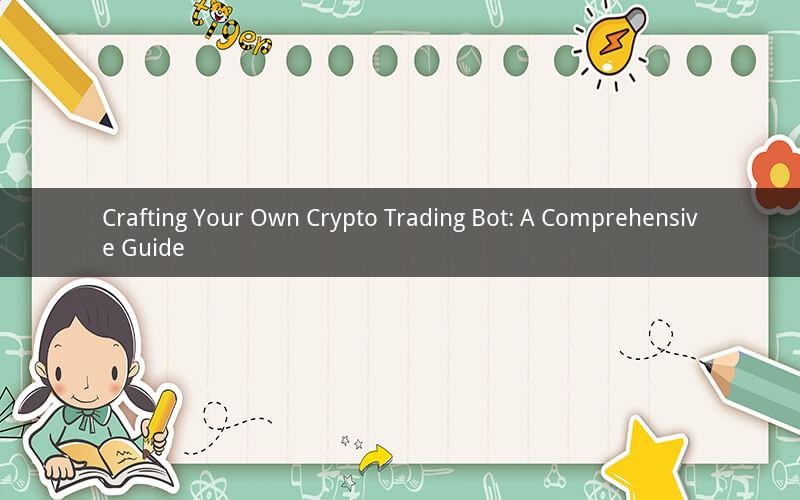
Introduction:
In the rapidly evolving world of cryptocurrencies, having a reliable trading bot can be a game-changer. These automated programs can execute trades at lightning speed, taking advantage of market opportunities that humans might miss. If you're interested in creating your own crypto trading bot, you've come to the right place. This guide will walk you through the essential steps and considerations to help you build a robust and efficient trading bot.
1. Understanding the Basics of Crypto Trading Bots:
Before diving into the technical aspects, it's crucial to have a clear understanding of what a crypto trading bot is and how it operates. A crypto trading bot is a software program designed to automate trading activities on cryptocurrency exchanges. It analyzes market data, identifies trading opportunities, and executes trades based on predefined rules and algorithms. By automating the trading process, bots can save time, reduce emotions, and potentially increase profitability.
2. Choosing the Right Platform:
To build your own crypto trading bot, you need to select a suitable platform. There are several options available, each with its own set of features and capabilities. Some popular platforms include:
- Binance: Known for its extensive range of cryptocurrencies and advanced trading features, Binance offers a powerful API for building trading bots.
- Kraken: Offering a wide range of cryptocurrencies and a user-friendly interface, Kraken provides a reliable platform for bot development.
- Coinbase Pro: As one of the largest cryptocurrency exchanges, Coinbase Pro offers a robust API and a large selection of trading pairs.
3. Setting Up Your Development Environment:
Once you have chosen a platform, the next step is to set up your development environment. This involves installing the necessary software and libraries to build and test your trading bot. Here are some essential tools and libraries you may need:
- Programming Language: Python is a popular choice for building crypto trading bots due to its simplicity and extensive library support.
- Libraries: Libraries like Pandas, NumPy, and Matplotlib can be used for data analysis and visualization.
- API Keys: Obtain API keys from your chosen cryptocurrency exchange to access market data and execute trades.
4. Designing Your Trading Strategy:
A successful trading bot requires a well-defined trading strategy. This involves identifying market trends, setting entry and exit points, and determining risk management parameters. Here are some key considerations for designing your trading strategy:
- Technical Analysis: Analyze historical price data and identify patterns or indicators that suggest potential trading opportunities.
- Fundamental Analysis: Consider factors like market sentiment, news events, and economic indicators that can impact cryptocurrency prices.
- Risk Management: Set appropriate risk levels, including stop-loss orders and position sizing, to protect your investments.
5. Implementing the Trading Bot:
With your strategy in place, it's time to implement the trading bot. This involves writing code that can analyze market data, execute trades, and handle various scenarios. Here's a high-level overview of the implementation process:
- Data Collection: Fetch market data from your chosen cryptocurrency exchange using the API.
- Data Analysis: Apply your trading strategy to the collected data, identifying potential trading opportunities.
- Trade Execution: Send trade orders to the exchange based on your analysis.
- Monitoring and Logging: Continuously monitor the bot's performance and log any relevant information for future analysis.
6. Testing and Optimization:
Once your trading bot is implemented, it's essential to thoroughly test and optimize it. This involves running the bot on historical data to simulate real-world trading scenarios. By analyzing the bot's performance, you can identify areas for improvement and refine your trading strategy.
7. Deploying the Trading Bot:
After testing and optimization, it's time to deploy your trading bot to a live environment. This involves running the bot on a server or using a cloud-based platform. Ensure that your bot is secure, regularly updated, and has proper error handling mechanisms in place.
8. Continuous Monitoring and Maintenance:
Building a successful crypto trading bot is just the beginning. Continuous monitoring and maintenance are crucial to ensure the bot's performance and adaptability to changing market conditions. Regularly review your trading strategy, analyze the bot's performance, and make necessary adjustments.
Conclusion:
Creating your own crypto trading bot can be a rewarding endeavor, offering the potential for increased profitability and efficiency in your trading activities. By following this comprehensive guide, you can navigate the essential steps and considerations involved in building a robust and efficient trading bot. Remember to continuously monitor and optimize your bot to adapt to changing market conditions and ensure long-term success.
Questions and Answers:
1. Q: Can I build a crypto trading bot without any programming experience?
A: While programming experience can be helpful, it is possible to build a crypto trading bot with some guidance and learning resources. There are various tutorials and online courses available that can help you get started.
2. Q: How do I choose the right trading strategy for my bot?
A: The choice of trading strategy depends on your risk tolerance, investment goals, and market analysis skills. It's important to research and understand different trading strategies before implementing them in your bot.
3. Q: Can a trading bot guarantee profits?
A: No, a trading bot cannot guarantee profits. The cryptocurrency market is highly volatile, and there are no foolproof strategies. It's crucial to manage risk and have realistic expectations.
4. Q: How can I ensure the security of my trading bot?
A: To ensure the security of your trading bot, use strong passwords, enable two-factor authentication, and keep your API keys and private keys secure. Regularly update your software and monitor the bot's performance for any suspicious activity.
5. Q: Can I use a trading bot for both long-term and short-term trading?
A: Yes, you can modify your trading bot to cater to both long-term and short-term trading strategies. Adjust the parameters and algorithms based on your trading preferences and market conditions.